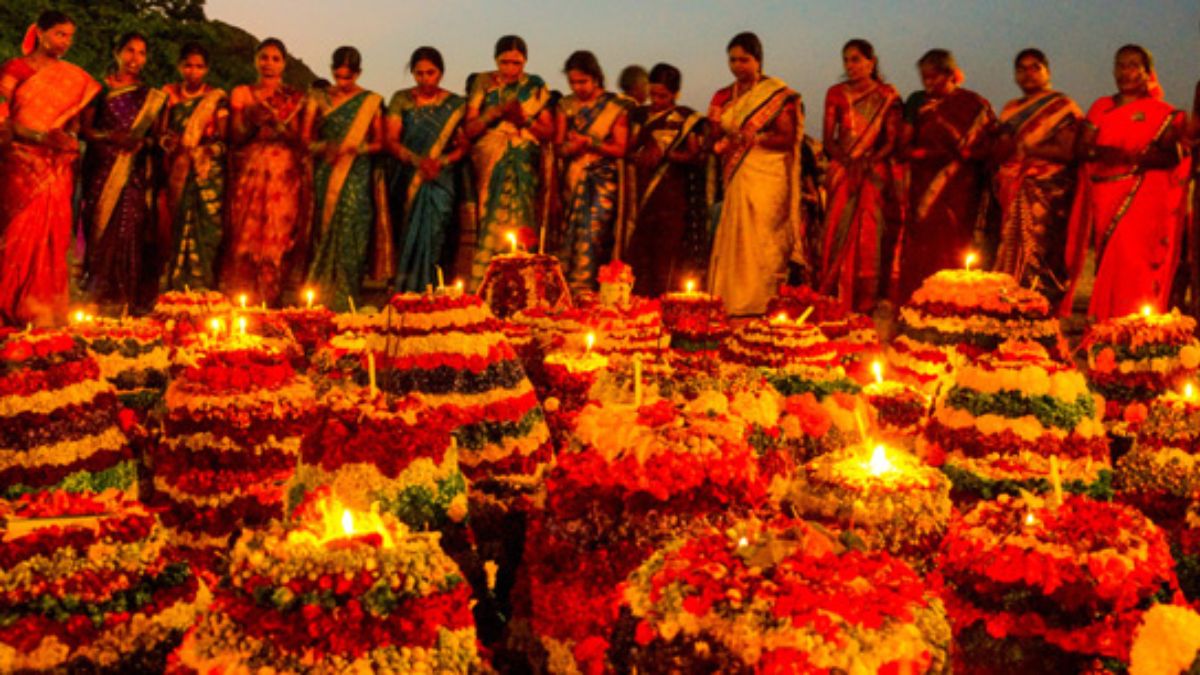
Telangana, with its rich cultural tapestry, boasts a variety of practices that reflect the region’s deep-rooted history. However, many of these traditions are rapidly disappearing due to modernization and changing societal preferences. This article highlights four cultural practices in Telangana that are on the brink of extinction, shedding light on their significance and the pressing need for preservation.
1. Bathukamma Festival – A Vanishing Tradition of Floral Worship
The Bathukamma festival is one of the most iconic traditions in Telangana, celebrated primarily by women to honor Goddess Gauri. The festival involves the creation of elaborate flower arrangements, called Bathukamma, which are arranged in a conical shape. Women sing traditional folk songs while immersing the flowers in water, signifying the worship of the goddess. The flowers used in Bathukamma are typically indigenous species, each carrying its own cultural significance.
However, the practice is slowly disappearing. Urbanization has led to a decline in the availability of these specific flowers, and many younger people are opting for more modern ways of celebrating, such as commercialized versions of the festival. With fewer people engaging in the creation of Bathukamma, the intricate art of arranging flowers is at risk of being lost. Efforts are being made to revive the practice, including promoting the cultivation of native flowers and encouraging younger generations to embrace traditional celebrations.
2. Pochampally Ikat Weaving – The Decline of an Ancient Art Form
Pochampally Ikat weaving is an ancient craft known for its striking geometric patterns and vibrant colors, created through a unique technique where the threads are dyed before being woven into fabric. The technique requires great skill, precision, and time, making each piece of Pochampally Ikat fabric a work of art. Traditionally, this craft has been passed down through generations, with artisans creating textiles for daily use as well as special occasions.
Unfortunately, this craft is facing extinction due to multiple factors. The rise of machine-made fabrics, which are cheaper and more accessible, has led to a reduction in demand for handmade textiles. Additionally, the younger generation is less inclined to take up weaving as a profession due to its labor-intensive nature and limited financial returns. To counter this decline, efforts are underway to revive the craft by organizing exhibitions, offering training programs, and promoting the global appeal of Pochampally Ikat in the fashion industry.
3. Koya Tribal Dance – A Unique Expression of Tribal Heritage
The Koya tribal dance is an important cultural expression of the Koya tribe, known for its intricate footwork, rhythmic beats, and energetic body movements. The dance is traditionally performed during festivals and community celebrations, and it serves as a celebration of nature, fertility, and ancestral spirits. The Koya people, who reside in the forests of Telangana, use the dance to convey their deep connection to their environment and cultural beliefs.
Despite its significance, the Koya dance is on the verge of disappearing. Urbanization, migration to cities, and a shift toward modern entertainment have led to a loss of interest among the younger generation in performing these traditional dances. Many of the elderly tribal members, who were the custodians of this art form, are aging, and fewer young people are learning these dances. In response, there are initiatives aimed at preserving the dance, such as training programs and cultural festivals that allow the younger generation to reconnect with their heritage.
4. Gussadi Dance – A Historical Ritual Dance on the Brink
Gussadi dance, performed by the Gussadi tribal community of Telangana, is a ritualistic and energetic dance traditionally performed to honor local deities and spirits. The dance, accompanied by drumbeats and rhythmic movements, is closely tied to agricultural cycles and is often performed during harvest seasons. The Gussadi dance is deeply rooted in the community’s history and is seen as a way to maintain a spiritual connection to their ancestors.
The decline of Gussadi dance is linked to the diminishing number of practitioners, largely due to urban migration and the loss of cultural identity among the younger generation. As younger members of the Gussadi tribe move to urban areas in search of better opportunities, the traditional practice is being forgotten. However, efforts to revitalize the dance include workshops, festivals, and community outreach programs aimed at educating the youth about the importance of preserving their cultural traditions.
Telangana’s rich cultural practices are a testament to the state’s diverse heritage. However, many of these traditions are at risk of disappearing due to various challenges, including urbanization, changing lifestyles, and the influence of modern culture. It is essential for both the state government and local communities to invest in the preservation of these cultural gems. By fostering awareness, providing training, and promoting these practices, Telangana can ensure that its rich cultural legacy is passed down to future generations.
